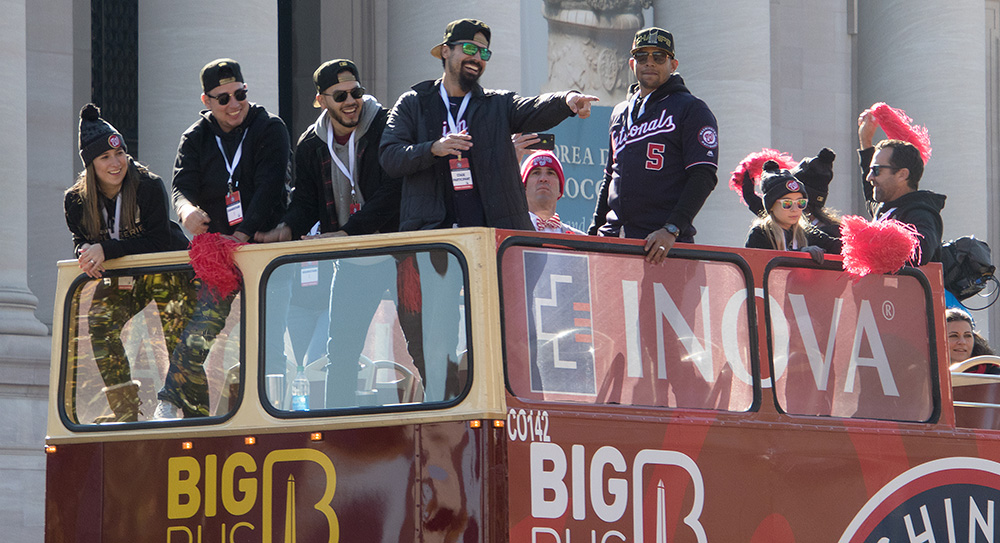Below is an analysis of the prospects in the farm system of the world champion Washington Nationals. Scouting reports are compiled with information provided by industry sources as well as from our own (both Eric Longenhagen’s and Kiley McDaniel’s) observations. For more information on the 20-80 scouting scale by which all of our prospect content is governed you can click here. For further explanation of the merits and drawbacks of Future Value, read this.
All of the numbered prospects here also appear on The Board, a new feature at the site that offers sortable scouting information for every organization. That can be found here.
Other Prospects of Note
Grouped by type and listed in order of preference within each category.
Younger Potential Helium Types
Pablo Aldonis, LHP
Viandel Pena, 2B
Junior Martina, SS
Yoander Rivero, SS
Daniel Marte, CF
Todd Peterson, RHP
Justin Connell, RF
Leandro Miliani, RF
Mirton Blanco, RHP
We’ll try to plow through these pretty quickly as this system has more of this tier of prospect than most clubs. Aldonis turns 18 in March. He’s a medium-framed, 6-foot-1, 55 athlete with a smooth delivery and advanced feel for three pitches. He’s a long-term physical projection sleeper. Pena is a stocky switch-hitter with bat-to-ball skills and he hit .360 in the GCL last year. He’s a 50 runner and infield defender who’s about 5-foot-7. It’s softer contact right now, but the barrel feel is there. Martina is a native of Curaçao and a 19th rounder out of Western Oklahoma St who crushed the GCL after the draft. He takes big hacks and could be a power-over-hit middle infield utility type. Rivero is an 18-year-old, glove-first shortstop. Peterson pitched in relief at LSU and would sit 92-94 with a 55 cutter/slider and curveball at times. Washington tried him in a rotation last summer. Connell and Miliani are bat-to-ball 1B/LF sorts; they have promising contact skills but probably need to end up with premium hit tools to profile. Blanco is a 17-year-old who has been up to 98 but he’s very wild.
Major League Ready Depth
Kyle Finnegan, RHP
Ben Braymer, LHP
Yadiel Hernandez, 1B/OF
Jordan Mills, LHP
Steven Fuentes, RHP
Andrew Lee, RHP
Nick Raquet, LHP
Tres Barrera, C
Nick Banks, OF
Jacob Condra-Bogan, RHP
Finnegan was a high-priority minor league free agent whose stuff was up late in the year, and has been strong in the Dominican Winter League. He’s in the mid-90s with an average slider and split. Braymer is also on the 40-man and looks like a lefty pitchability swingman with a 55 breaking ball. Hernandez is a weird one. He signed out of Mexico at age 29 and is now 32, but he rakes (it’s hit over power due to lack of launch, but the contact is very hard) and because of when he signed, he acts as upper-level depth without occupying a 40-man spot this year, so he has sneaky trade value. Jordan Mills sits upper-80s with sink, his changeup is plus, and his slider above average. Fuentes has reached Double-A and has a tailing low-90s fastball and above average changeup. Lee and Raquet are overhand four-seam, curveball relief types. Barrera is on the 40-man right now and is a well-rounded third catcher. Banks has several above average tools (speed underway, raw power, arm strength) but the bat is below. Condra-Bogan is significant because he’s the only player on this whole list who arrived by trade (he came back from Kansas City in the Brian Goodwin deal), as everyone else was drafted or signed by Washington. JCB touches 100; he’s still working on a breaking ball.
A Complete Mess of Other Guys
Jake Irvin, RHP
Fausto Segura, RHP
Jakson Reetz, C
Orlando Ribalta, RHP
J.T. Arruda, SS
Jhonatan German, LHP
Gage Canning, CF
Alex Troop, LHP
Felix Taveras, RHP
Several of these guys signed late out of Latin America, around age 21. Segura (23, NYPL) has a chuck-it-past-you fastball up to 98, German (24, Double-A) has a mid-90s sinker, and Taveras (24, GCL) has been hurt for most of the past three years but was up to 97 with 2500 rpm on the heater. Irvin was up last spring, down last summer, then up again during instructs, where he pitched in relief. He’s 6-foot-6 and sits 93-96 when things are right with an average curveball. Reetz is another athletic, late-bloomer type who makes consistent hard contact; he’s probably a depth catcher. Ribalta is a big-bodied fastball/curveball relief prospect who was up to at least 96 at Miami Dade College the summer after the draft. Arruda was a sophomore-eligible 11th rounder. He’s a lefty-bat infielder with good feel to hit. Troop is a lanky, over-the-top lefty whose fastball has carry.
System Overview
This system is not very good for very good reasons. Prospects have either been traded away (Elvis Alvarado, Jesus Luzardo, Yohanse Morel, Kelvin Gutierrez, Daniel Johnson, Taylor Hearn, Sheldon Neuse, Dane Dunning) or they’ve graduated (Juan Soto, Victor Robles), and several draft picks have been lost as compensation for free agents because the Nats have been busy winning. And so the list above includes just one player who wasn’t originally signed or drafted by Washington; they haven’t been in prospect acquisition mode for a long time.
Once Carter Kieboom graduates off the list, would you rather have this entire system or the Vanderbilt Commodores? It’s probably pretty close.

